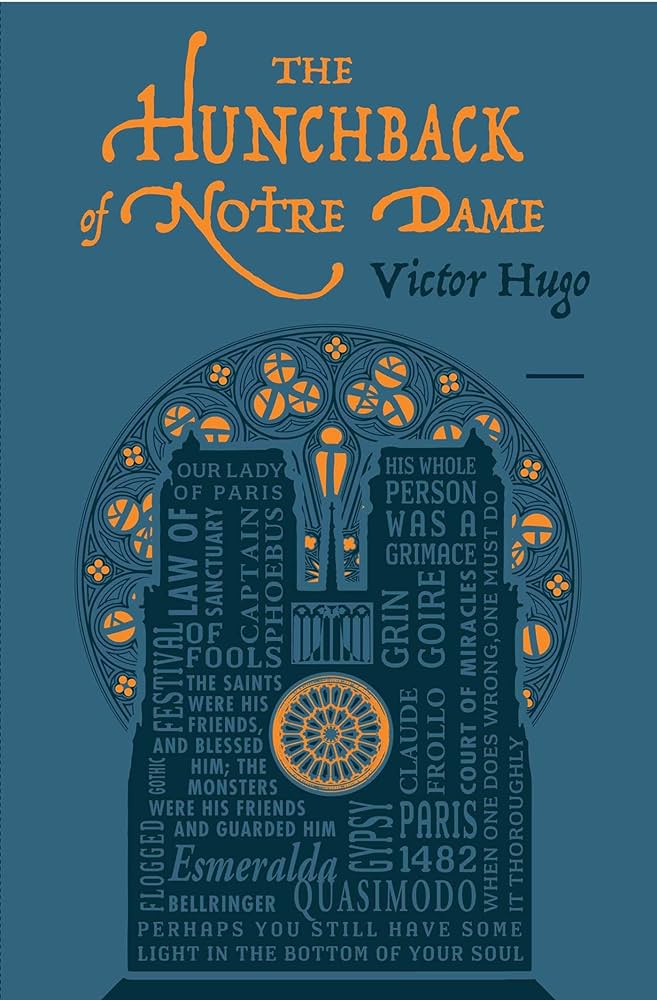The Hunchback of Notre-Dame is a French Gothic novel penned by Victor Hugo, hitting the shelves in 1831. The title draws attention to the Notre-Dame Cathedral, a central motif throughout the narrative. At its heart lies the poignant tale of Quasimodo, the hunchbacked bell ringer, Esmeralda, a Roma street dancer, and Claude Frollo, Quasimodo’s guardian and the Archdeacon of Notre-Dame, all set against the backdrop of 15th-century Paris.
The Hunchback of Notre-Dame weaves together a tapestry of elements—its Renaissance-era setting, intricate love stories, and the portrayal of marginalized characters—to epitomize the literary themes of Romanticism. Through its richly detailed portrayal of medieval Paris, complex characters, and exploration of themes such as love, obsession, and societal injustice, The Hunchback of Notre-Dame remains a quintessential example of Romantic literature, captivating readers with its evocative storytelling and timeless themes.
Summary Of The Hunchback of Notre-Dame
During the Paris Fool’s Festival in 1482, Quasimodo, the hunchbacked man of Notre Dame, is chosen as the Pope of Fools because he is deemed the ugliest person in Paris. He is elevated onto a throne and paraded through the streets of Paris by a mocking crowd. Pierre Gringoire, a struggling poet and philosopher, attempts unsuccessfully to invite the crowd to watch his own play. Archdeacon Claude Frollo appears, halts the procession, and sends Quasimodo back to Notre Dame.
Gringoire, seeking something to eat, becomes enamored with the graceful beauty of La Esmerelda, a street dancer of the gypsies, and decides to follow her home. Around a corner, he is suddenly attacked by Quasimodo and Frollo. Gringoire rushes to help but is knocked unconscious by Quasimodo while Frollo escapes. The King’s Archers, led by Phoebus de Chateaupers, arrive in time and apprehend the hunchback. That same night, a group of beggars and thieves are about to hang Gringoire when La Esmerelda steps forward and offers to save his life by “marrying” him for only four years.
The next day, Quasimodo is brought to trial and subjected to two hours of torture in Grève Square. He suffers the pain of being stretched and torn while openly humiliated by the crowd that harbors resentment toward him due to his ugliness. When he asks for water, no one responds to his pleas until La Esmerelda steps forward and brings him a drink. Sister Gudule, a nearby recluse, screams at La Esmerelda, calling her a “gypsy child thief” and holds her responsible for the abduction of her daughter fifteen years ago.
Several months later, while La Esmerelda is dancing in front of Notre Dame, Phoebus calls her over. He has fallen in love with her and blushes with embarrassment when he asks her to meet him later that night. Frollo watches them from the top of Notre Dame’s tower and feels mad jealousy towards Phoebus.
His obsessive desire for La Esmerelda leads him to forsake God and pursue alchemy and black magic. In his secret chamber in Notre Dame, he plans to trap La Esmerelda like a spider catching its prey in a web. That same night, he follows Phoebus to his meeting with La Esmerelda and repeatedly stabs him. He flees, and La Esmerelda is captured by the King’s guards.
During her trial, La Esmerelda, tortured, falsely confesses to murdering Phoebus and being a witch. She is condemned to be hanged in Grève Square. Frollo visits her in prison and declares his love for her, pleading for her affection and mercy, but she addresses him as a “monk-fiend” and a murderer, denying any connection with him. Before her execution, La Esmerelda is publicly humiliated in front of the crowd in front of Notre Dame. While looking at the square, she suddenly sees Phoebus and shouts his name. He has actually survived the murder attempt but does not want anyone to know he was injured.
He walks away from La Esmerelda and enters his fiancée’s house. At that moment, Quasimodo swings down from Notre Dame on a rope and cries out, “Sanctuary!” taking her back to the cathedral. La Esmerelda, by remaining in the cathedral, is saved from execution. Initially, it is difficult for her even to look at Quasimodo, but an uneasy friendship develops between them. Though deaf, he enjoys being near her when she sings.
Meanwhile, a group of beggars, upon hearing that the Parliament has decided to remove La Esmerelda from Notre Dame, decides to rescue her. However, when Quasimodo sees them attacking the cathedral, he assumes they have come to kill La Esmerelda and fiercely opposes them, killing many. Frollo, using the attack as a distraction, manages to take La Esmerelda away from the cathedral. He gives her two choices: either confess her love for him or be executed. Frollo demands her execution and leaves her alone with Sister Gudule.
In their astonishment, they discover they are mother and daughter. Gudule tries to protect La Esmerelda, but it is too late. When Quasimodo returns to Notre Dame, he takes her to the top of the northern tower to find her. As he looks into the distance, he sees the hanging figure of La Esmerelda in her white dress. With despair, he grabs Frollo by the throat, holding him in the air, and then throws him down, causing his death. Looking at the hanging La Esmerelda and the writhing corpse of Frollo below, Quasimodo cries out, “All that I loved!” Quasimodo is never seen again. Years later, a gravedigger finds the remains of La Esmerelda, surrounded by the hunchbacked skeleton.




I was reading through some of your posts on this site and I believe this website is
really instructive! Continue putting up.?